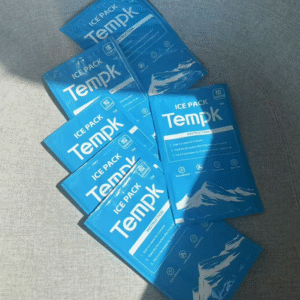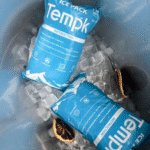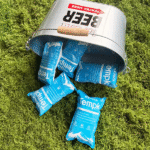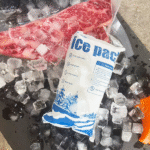¿Cuánto cuesta una bolsa de hielo seco?? Factores que afectan el precio y la elección de la opción correcta
¿Está considerando el costo de las bolsas de hielo seco para sus necesidades de envío?? En esta guía, Desglosaremos los factores de precios que influyen en los costos de las bolsas de hielo seco., Ayudándolo a tomar decisiones informadas al elegir la solución adecuada para sus requisitos de envío de cadena de frío.. Si está enviando productos farmacéuticos, alimentos perecederos, o artículos especiales, Comprender los precios del hielo seco es esencial para gestionar los gastos de envío de forma eficaz..

¿Qué factores influyen en el costo de las bolsas de hielo seco??
-
Tamaño y peso de la bolsa de hielo seco
-
Materiales de embalaje y durabilidad
-
Requisitos de temperatura y duración
-
Ubicación de envío y velocidad de entrega
¿Por qué los precios del hielo seco son tan variados??
Costos de la bolsa de hielo seco fluctúan según varios factores que incluyen la cantidad de hielo seco, el tipo de embalaje, y necesidades de envío específicas. El peso del hielo seco utilizado juega un papel crucial a la hora de determinar el precio: más peso significa mayores costes., ya que se requiere más hielo seco para mantener una temperatura más baja durante un período más largo.
Peso y tamaño del hielo seco
Uno de los determinantes del costo más importantes de las bolsas de hielo seco es la cantidad de hielo seco necesaria.. Los envíos más grandes requieren más hielo seco, y así, costos más altos. Por ejemplo, una típica bolsa de hielo seco de 24 celdas (acerca de 5 libras) es adecuado para un envío de 24 horas, mientras que los envíos más grandes pueden requerir hasta 10 libras de hielo seco, lo que aumenta significativamente el precio.
| Tipo de paquete | Peso del hielo seco | Tiempo de uso | Costo promedio |
|---|---|---|---|
| 24-hoja celular | 5 libras | 24 horas | $15 – $30 |
| Paquete de hielo seco mediano | 10 libras | 48 horas | $40 – $60 |
| Bolsa de hielo seco grande | 20 libras | 72 horas | $80 – $100 |
Materiales de embalaje y durabilidad
El tipo de material de embalaje utilizado para las bolsas de hielo seco también juega un papel importante en el costo. bolsas de mylar, por ejemplo, Suelen ser más caras que las bolsas de papel Kraft, pero ofrecen un mejor aislamiento.. Al seleccionar bolsas de hielo seco, Considere si el material de embalaje cumple con los requisitos de aislamiento y duración del envío..
Requisitos de temperatura y duración del envío
Los tiempos de envío más largos o los requisitos de temperaturas extremas aumentarán el costo de las bolsas de hielo seco. Si su envío necesita permanecer frío por más de 24 horas, Es posible que necesites usar bolsas más gruesas o aislamiento adicional., lo que aumenta tanto los costos de embalaje como de hielo seco.
¿Cómo se pueden reducir los costos de envío de hielo seco??
Reducir los costos de las bolsas de hielo seco Implica una combinación de optimización del tamaño de los envíos., seleccionar el aislamiento apropiado, y entender a los proveedores locales. Aquí hay algunas estrategias:
-
Tamaño preciso: Evite sobreestimar sus necesidades de hielo seco. Asegúrese de que el paquete coincida con la duración exacta de la temperatura requerida para su producto.
-
Negociar con Proveedores: Muchos proveedores ofrecen descuentos por volumen., Entonces, si envías grandes cantidades con frecuencia, negociar precios más bajos.
-
Seleccione aislamiento eficiente: Invierta en aislamiento de alta calidad que mantenga la temperatura de manera efectiva con un mínimo de hielo seco..
Elegir el tamaño adecuado de la bolsa de hielo seco
Seleccionando la derecha tamaño de la bolsa de hielo seco garantiza que no desperdicie dinero en exceso de hielo seco, ni correr el riesgo de dañar el producto debido a una refrigeración insuficiente. Para envíos cortos (bajo 24 horas), paquetes más pequeños (5 libras o menos) suelen ser suficientes. Para envíos más largos, considere paquetes más grandes, pero sólo si es necesario para mantener el producto seguro.
¿Cuáles son los diferentes tipos de envases de hielo seco??
Existen varios tipos de soluciones de envasado con hielo seco., cada uno adaptado a necesidades específicas. Estos incluyen:
-
Paquetes de hielo seco estándar: Comúnmente utilizado para envíos pequeños y medianos y mantenimiento de temperatura menos crítica..
-
Bolsas aisladas personalizadas: Ideal para envíos especializados que requieren un control preciso de la temperatura durante períodos más largos.
Costos estándar de la bolsa de hielo seco
Las bolsas de hielo seco estándar pueden variar desde $10 a $30 dependiendo del peso y embalaje. Son adecuados para la mayoría de las empresas de comercio electrónico., productos farmaceuticos, y alimentos con un 1-2 vida útil del día.
Paquetes de hielo seco con aislamiento premium
Paquetes premium, con aislamiento mejorado, costo entre $40 y $100 o más. Se utilizan para envíos más exigentes donde el control preciso de la temperatura es crucial.. Son perfectos para suministros médicos., vacunas, o productos alimenticios gourmet que requieren una vida útil prolongada.
Costo del hielo seco para envío por industria
-
Productos farmacéuticos: El envío de suministros médicos y vacunas normalmente requiere un control de temperatura más preciso y un embalaje especializado., aumentando los costos.
-
Alimentos y Bebidas: Los productos perecederos, como los alimentos congelados o los chocolates, requieren un buen mantenimiento de bajas temperaturas., Influir en el embalaje y la selección de hielo seco..
-
Comercio electrónico: Muchos vendedores de comercio electrónico utilizan hielo seco para enviar productos sensibles a la temperatura, como cosméticos o alimentos premium., pero normalmente, equilibran costo y eficiencia.
¿Existen alternativas al hielo seco para el envío??
Sí, Existen alternativas al hielo seco que pueden ser más rentables según sus necesidades específicas.:
-
Materiales de cambio de fase (PCM): Los PCM son ideales para mantener una temperatura específica durante períodos más prolongados., sin el frío extremo del hielo seco.
-
Paquetes de gel: Son útiles para requisitos de temperatura menos extrema y pueden ser una opción más asequible..
¿Cómo se comparan los materiales de cambio de fase con el hielo seco??
Materiales de cambio de fase, A diferencia del hielo seco, Puede mantener temperaturas dentro de un rango específico., haciéndolos ideales para envíos sensibles que no requieren temperaturas ultrabajas. El costo puede variar pero generalmente, Los PCM tienden a ser más asequibles a largo plazo ya que no se subliman tan rápido como el hielo seco..
| Material | Rango de temperatura | Comparación de costos | Mejor para |
|---|---|---|---|
| Hielo seco | -78.5°C | Más alto | Enfriamiento crítico |
| Material de cambio de fase | -20°C a -25°C | Más bajo | Productos farmacéuticos |
| Paquetes de gel | 0°C a 10°C | Más bajo | Perecederos Generales |
Cómo elegir la mejor bolsa de hielo seco para sus necesidades de envío?
Para elegir la mejor bolsa de hielo seco, considere los siguientes factores:
-
Duración del envío: Si el envío dura más de 24 horas, opte por paquetes más grandes o aislamiento premium.
-
Sensibilidad al producto: Los artículos más sensibles pueden requerir paquetes de mayor calidad.
-
Presupuesto: Equilibre su necesidad de refrigeración con su presupuesto disponible.
2025 Tendencias en los costos de envío de hielo seco
A medida que avanzamos hacia 2025, el costo del envío con hielo seco Se espera que evolucione con nuevas tecnologías y materiales.. Innovaciones en tecnologías de aislamiento y se prevé que métodos de producción de hielo seco más eficientes reducirán los costos., especialmente a granel. Además, la tendencia de sostenibilidad está impulsando a la industria a explorar alternativas más ecológicas al hielo seco, como materiales de cambio de fase ecológicos.
El futuro del hielo seco y los costos de envío
-
Enfoque de sostenibilidad: Espere que haya más opciones ecológicas disponibles, Impulsar una reducción del impacto ambiental manteniendo al mismo tiempo la eficiencia de refrigeración..
-
Soluciones de envío inteligentes: Tecnologías emergentes como sensores inteligentes permitirá un mejor control de la temperatura, reduciendo la necesidad de uso excesivo de hielo seco.
Preguntas comunes sobre los costos del hielo seco
¿Cuánto cuesta el hielo seco por libra??
El hielo seco normalmente cuesta entre $1.50 y $3.00 por libra, dependiendo de la ubicación y la cantidad comprada.
¿Puedo reutilizar hielo seco para envíos??
En algunos casos, El hielo seco se puede reutilizar si no se ha sublimado por completo.. Sin embargo, es mejor utilizar hielo seco fresco para envíos críticos.
Conclusión: Comprender los costos de las bolsas de hielo seco
En resumen, el costo de las bolsas de hielo seco está influenciado por varios factores, incluido el tamaño, materiales de embalaje, y duración del envío. Entendiendo estas variables, puede gestionar mejor los gastos de envío y al mismo tiempo garantizar la entrega segura de sus productos sensibles a la temperatura. Esté atento a las tendencias en evolución, como opciones sostenibles y tecnologías de envío más inteligentes, para optimizar aún más los costes.
Obtenga asesoramiento de expertos de Tempk
Y tempk, Nos especializamos en brindar soluciones personalizadas de cadena de frío., incluyendo bolsas de hielo seco, materiales de cambio de fase, y soluciones de envío con temperatura controlada. Nuestros productos están diseñados para garantizar el transporte seguro y rentable de artículos sensibles a la temperatura..























